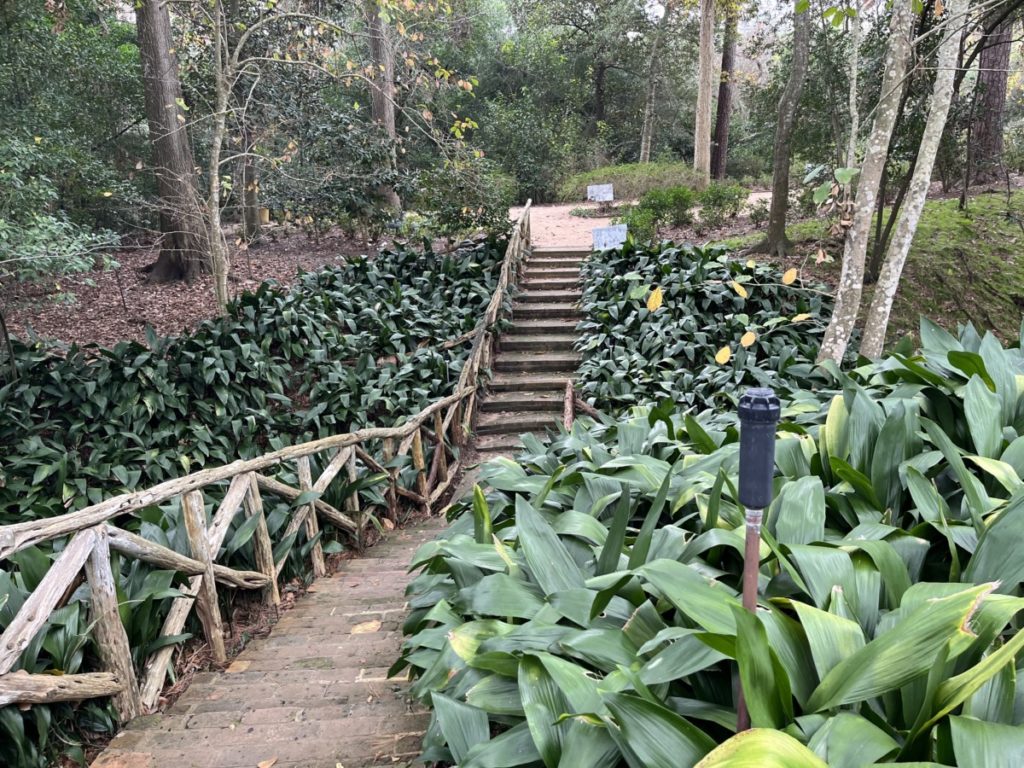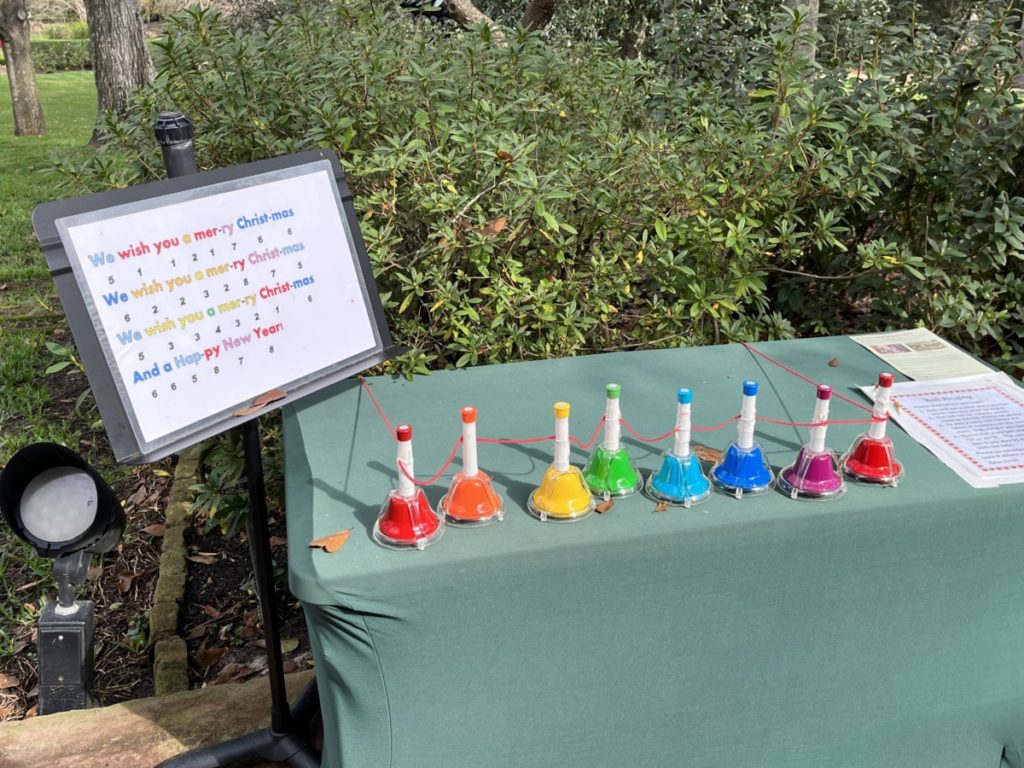We visit family so often in Houston that we forget to take advantage of the many museums, gardens, and other activities. On our recent trip, I took Thing 2 with me to Bayou Bend, the mansion and gardens of the late Houston philanthropist, Ima Hogg. Not knowing what to expect, we thoroughly enjoyed ourselves and left with a better understanding of Houston’s history.
The Visitor Center
Our introduction to Ima Hogg began at the Kilroy Visitor Center. The sleek, light-filled building housed three short films including an overview, the house, and the gardens. An exhibition room gave a synopsis of the Hogg family.
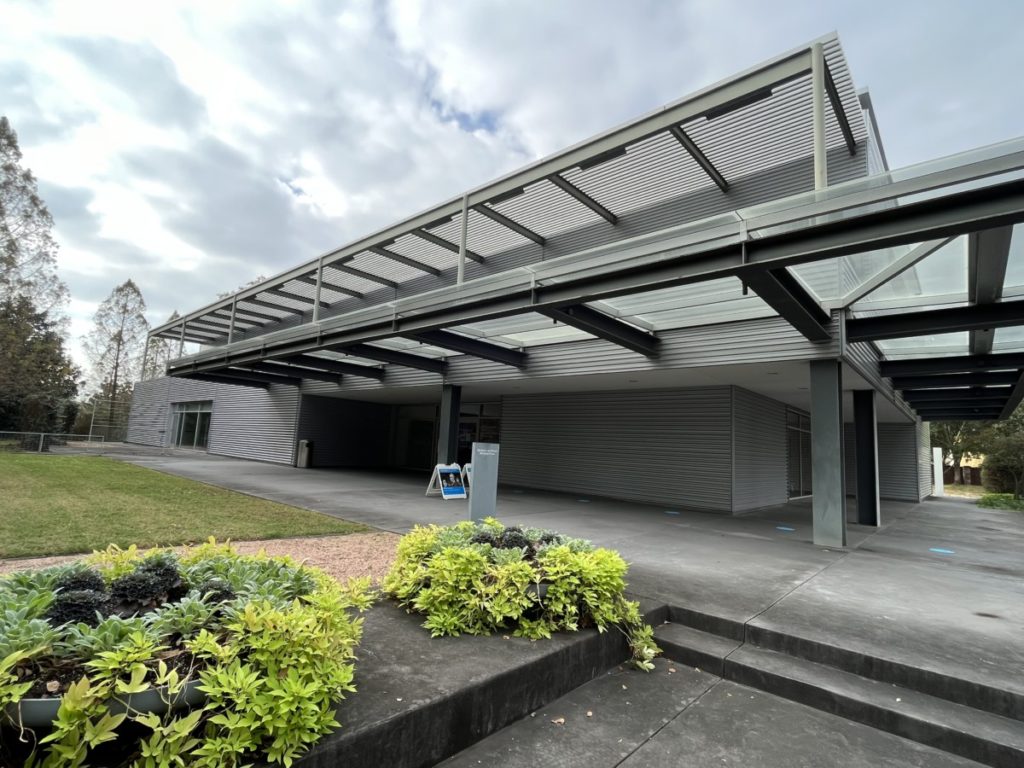
Born and raised in East Texas, the family patriarch, James Stephen “Big Jim” Hogg, served as Attorney General and later Governor of Texas from 1891-1895. His only daughter was Ima, but two of his three sons, Will and Mike, along with their friend Hugh Potter, developed the posh River Oaks neighborhood in Houston in the 1920s.
The Gardens
Bayou Bend features gardens – plural. After crossing the suspension bridge over Buffalo Bayou, we accessed the mobile link for the self-guided tour. With both listening and reading options, we started our journey through the 14-acre grounds. With Houston temps in the high 70s this late December day, it was the perfect weather to explore the gardens.
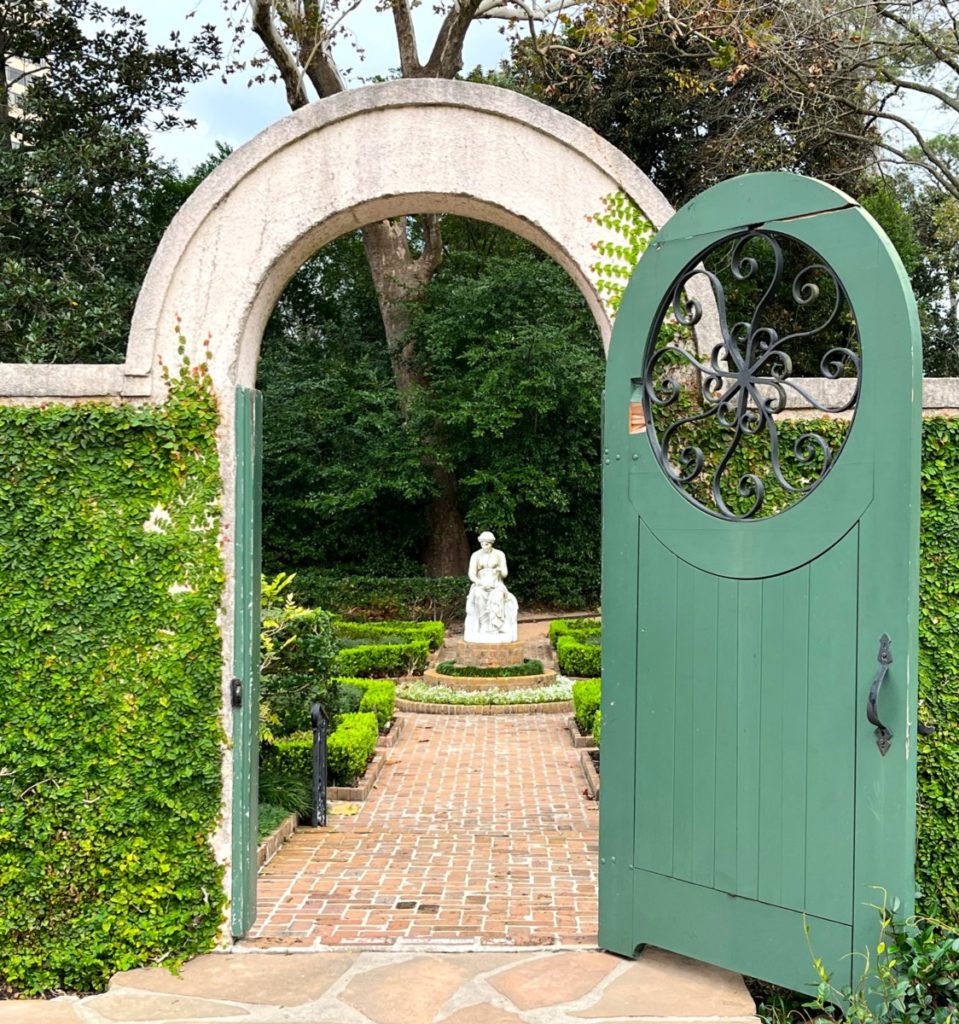
Many of the gardens host statues and their own theme. Featuring the muse of history, the Clio Garden was structured with boxwoods, while the Euterpe Garden felt informal with a shady walkway lined with azaleas. Less prominent, the marble figure of Euterpe – the muse of music and poetry – adds interest.
The showpiece is definitely the Diana Gardens. The statue of Diana gazes beyond the rectangle-shaped reflecting pool with arched-fountains directly to the house. Built in 1927 by John Staub, the light pink stucco mansion features two stories with floor-to-ceiling windows and wrought-iron railings. To me, it resembles a plantation home, while experts say it draws from New Orleans, Charleston, and Latin-inspired architecture.
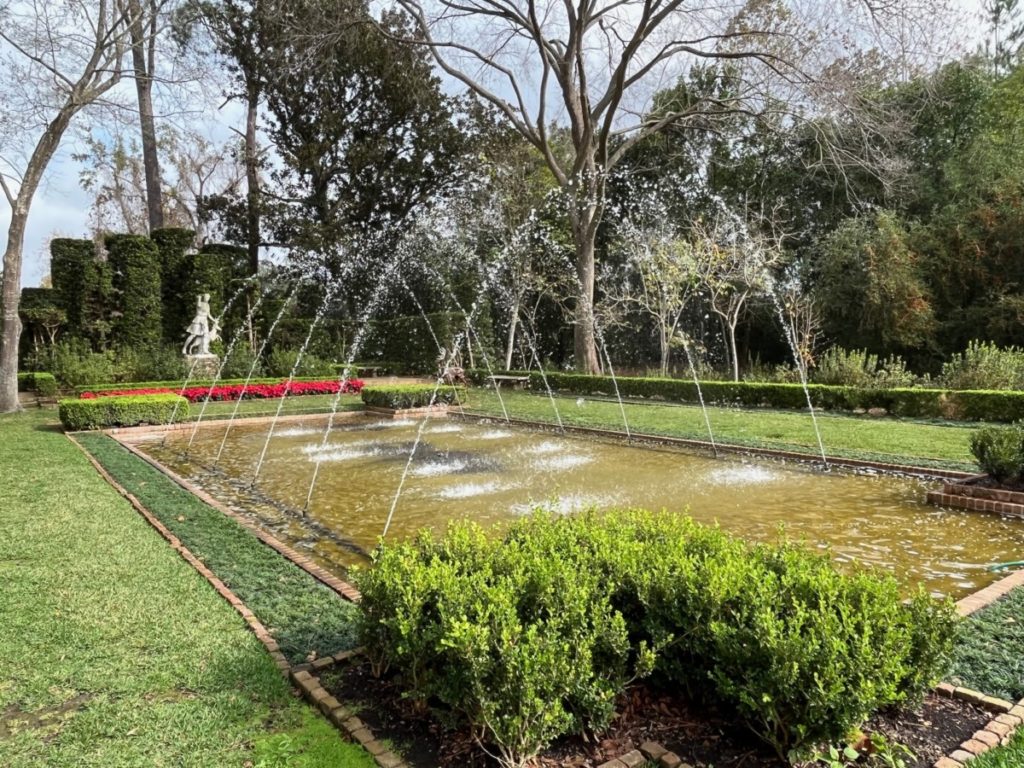
The Woodland Ravines garden displays native plants such as ferns and a small wooden bridge, while the Butterfly Gardens is more formal and the bright flowers stand tall in a butterfly formation. During the holidays, the museum placed bright-colored handbells throughout the grounds. Visitors were encouraged to look at the sheet music with corresponding colors to play various carols.
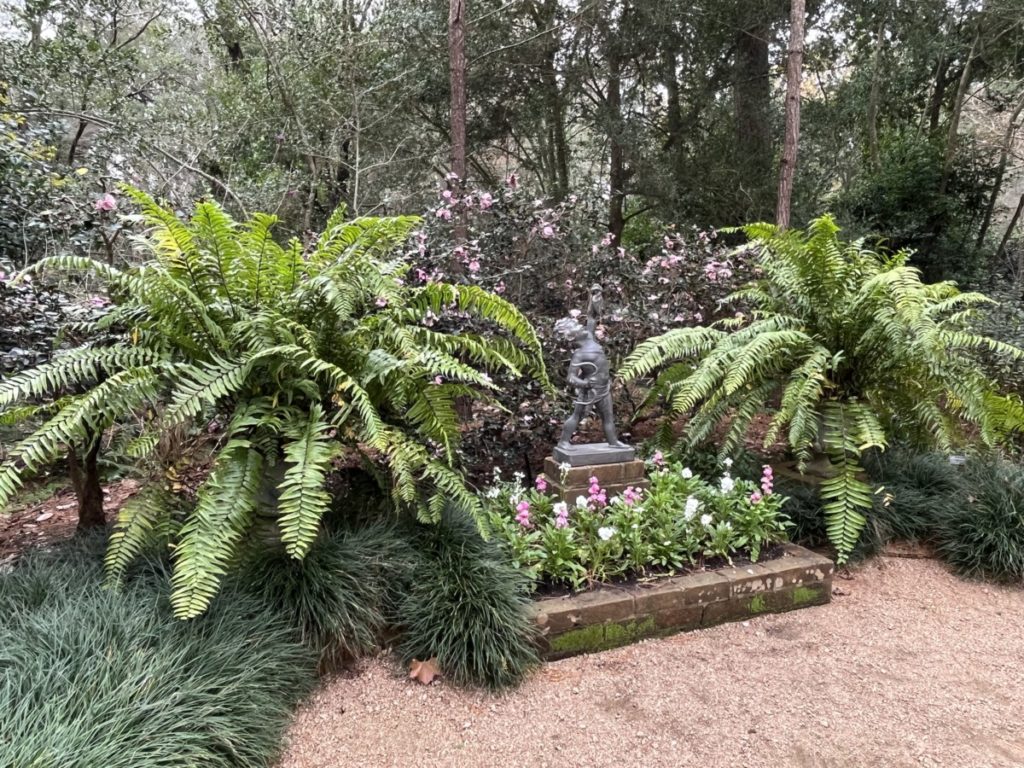
While most flowers weren’t in season, the Camelia Walk boasted a few blooms for us to enjoy. After the White Garden, where only white-blooming flowers live, we walked up the main drive to the mansion.

Personally, the front drive doesn’t offer the best view of the house. The grandest view lies on the backside with four large columns and a patio area that overlooks a grassy terrace and the Diana Garden.
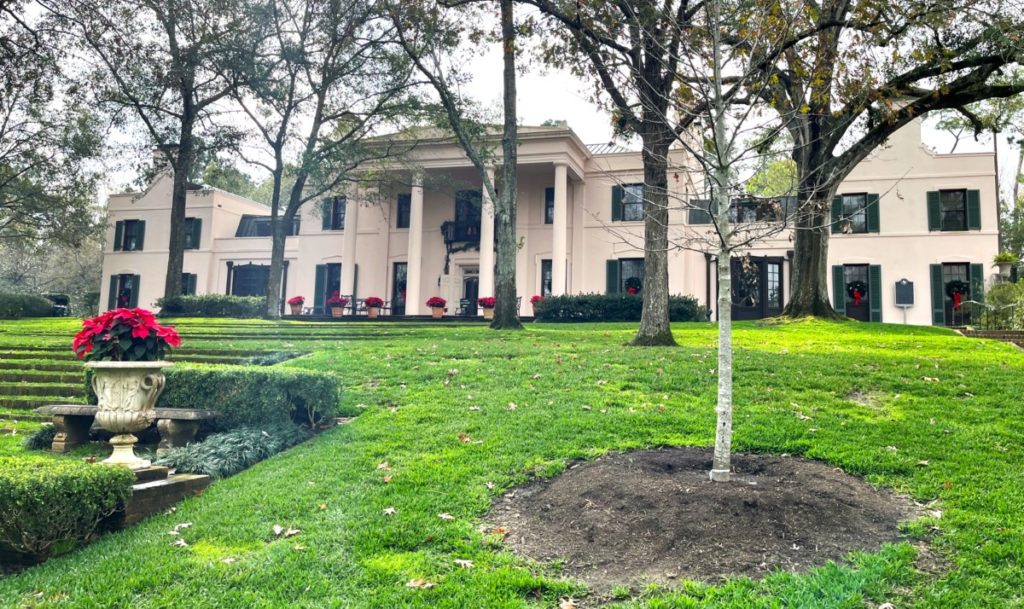
The Mansion
Although Hogg’s brothers started River Oaks, Bayou Bend wasn’t the first house built. That honor belongs to William and Susan Clayton, whose 1924 home served as their summer cottage away from downtown Houston.
Hogg moved into Bayou Bend in November 1928 with her two brothers, Will and Mike. All three lived there together until Mike got married. Then in 1930, while traveling in Europe, Will Hogg died at age 55. Mike followed in 1941.
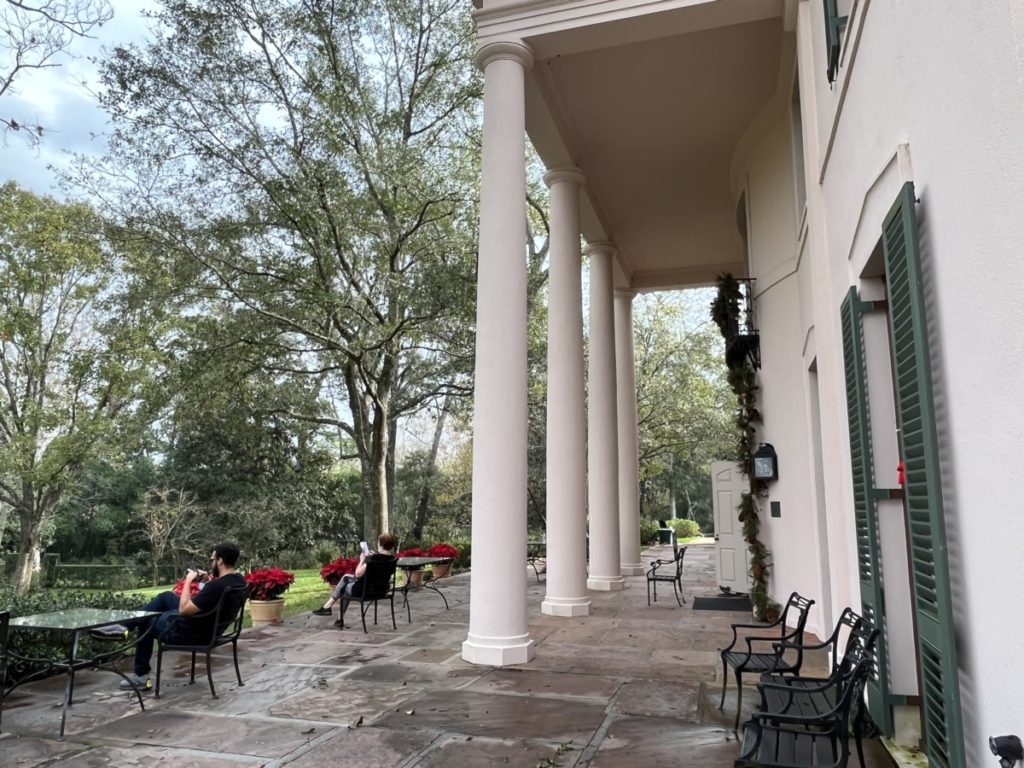
After living alone for several decades and having no direct heirs, Hogg decided to donate her estate to the Museum of Fine Arts Houston (MFAH). She spent the years 1957-1966 tirelessly working on creating the museum with her extensive collection of antiques and early American furniture.
First Floor
The air conditioning felt good when we entered the mansion at the southeastern wing. The first room in the wing, the Murphy Room displayed early American furniture from 1620-1725. At first, I thought the furnishings looked sparse in relation to the house. However, In preparation for the museum, Hogg repurposed many rooms for them to look authentic to the collection and time period presented. This room represents what furnishings would look like in the 1600s, not when she lived here in the 1930s-1960s. When Hogg resided in the house, this room originally served as a game room, kitchen, and bathroom area.

Moving along the audio tour, dark blue walls greeted us in the Massachusettes Room, featuring early Colonial furnishings from 1660-1790. For me, the room resembled the interior of Mount Vernon and historic Williamsburg homes.
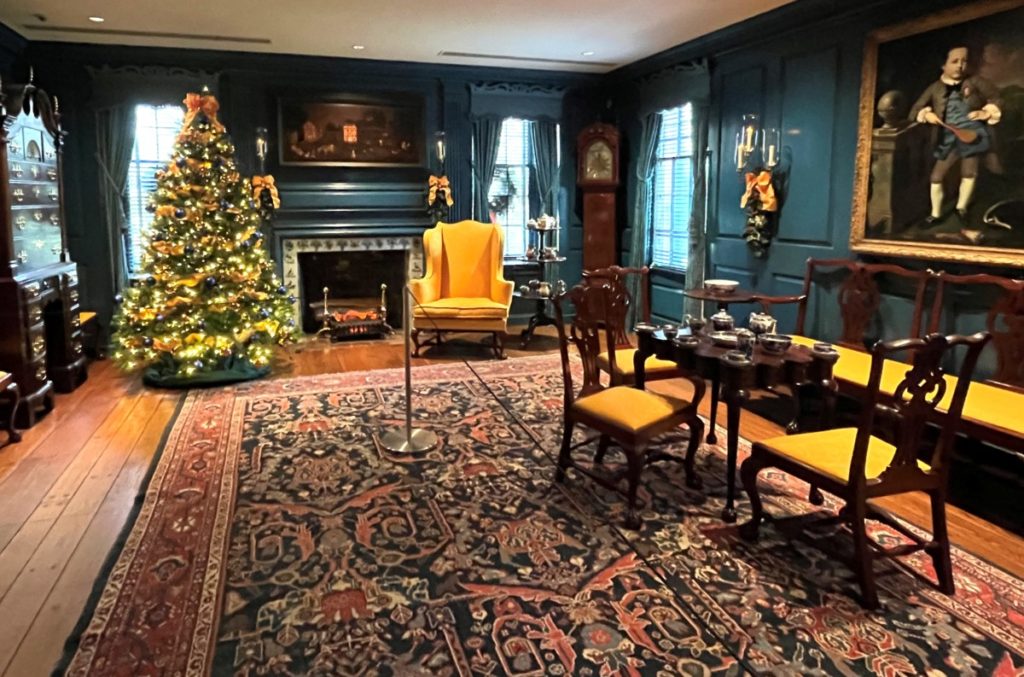
The wood-paneled, Pine Room followed. Originally serving as the library, the staff can remove the panels to reveal the bookshelves that still line the wall.
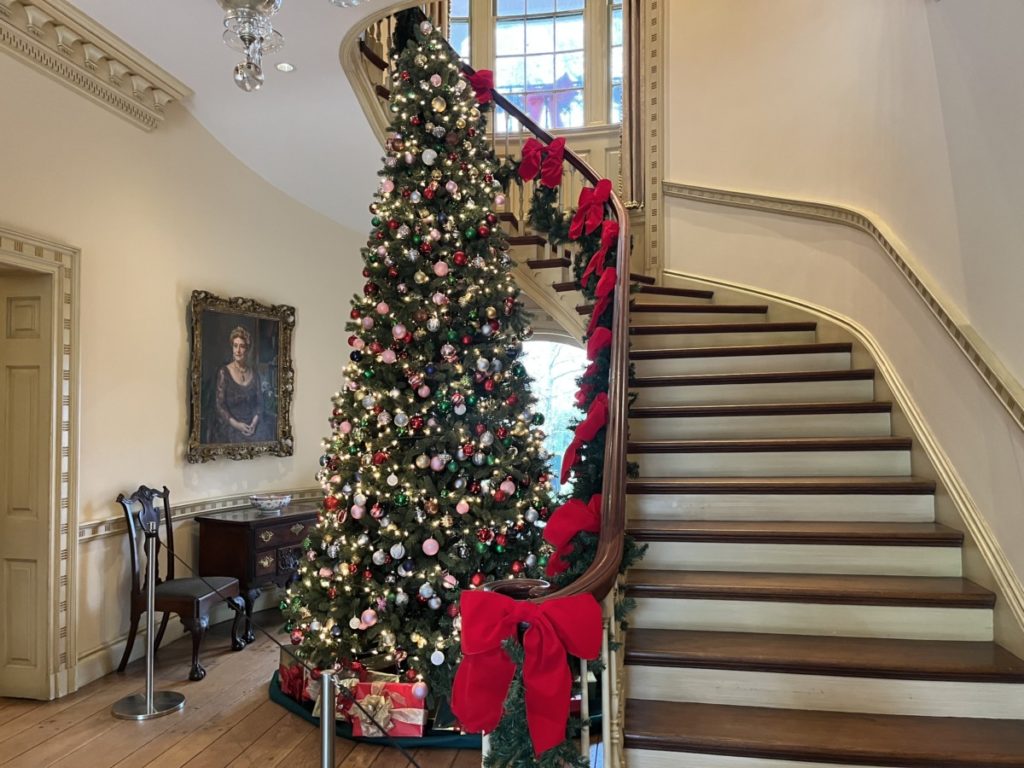
Flanked on each side by the Drawing Room and the Dining Room, is the Philadelphia Hall. This lavish entrance hall, where guests would enter the house when visiting Hogg, was my favorite space. The staircase stands proud and closely resembles the staircase at the Governor’s mansion when Hogg lived there in the early 1890s. Soft pink ornaments hung on the tree between the staircase and a portrait of Hogg. The hall featured large doors on each end – one leading to the front drive and the other going out to the patio and the Diana Garden.
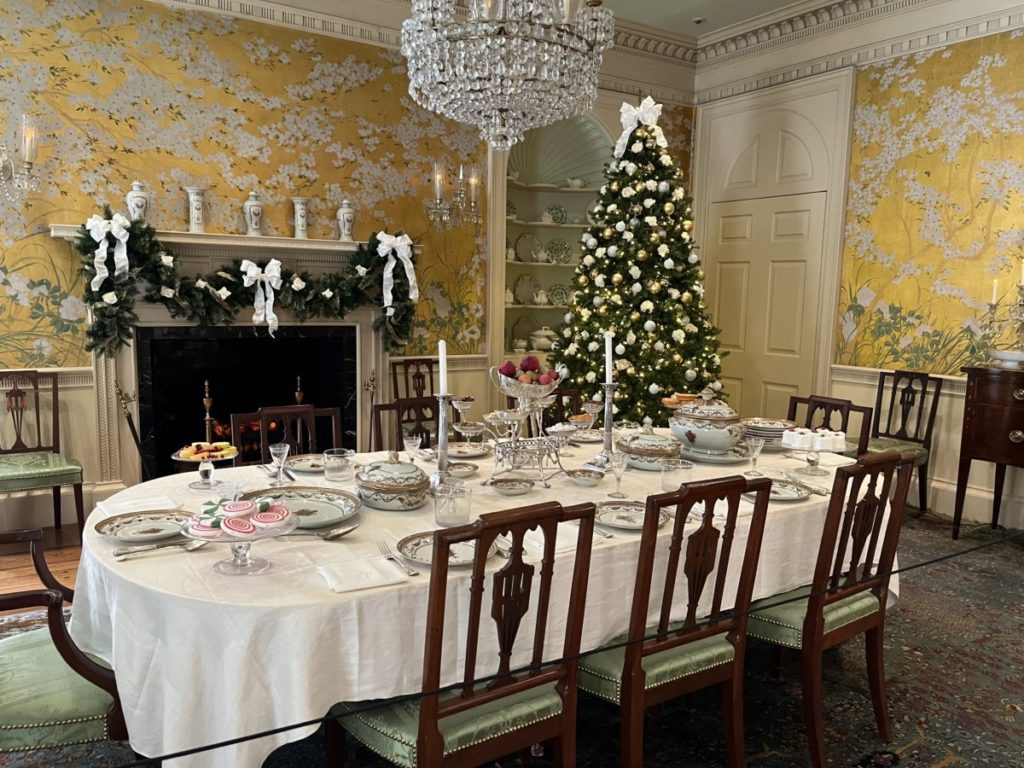
The Drawing Room, in muted yellow tones, featured more Federal-style furnishings. However, the wow factor came from the Dining Room with the bright gold, hand-painted wallpaper. When Hogg commissioned the wall coverings, she asked it to detail things grown around the Houston area. The designer featured dogwoods and butterflies, but also peonies, which unbeknownst to him, aren’t native to Houston.
A much smaller room off Philadelphia Hall, the Belter Parlor, showcased Victorian-era furnishings accented by heavy red velvet fabrics, reminding me of my grandmother’s formal living room. Not part of the original house, the intricate marble mantel dates from 1845.
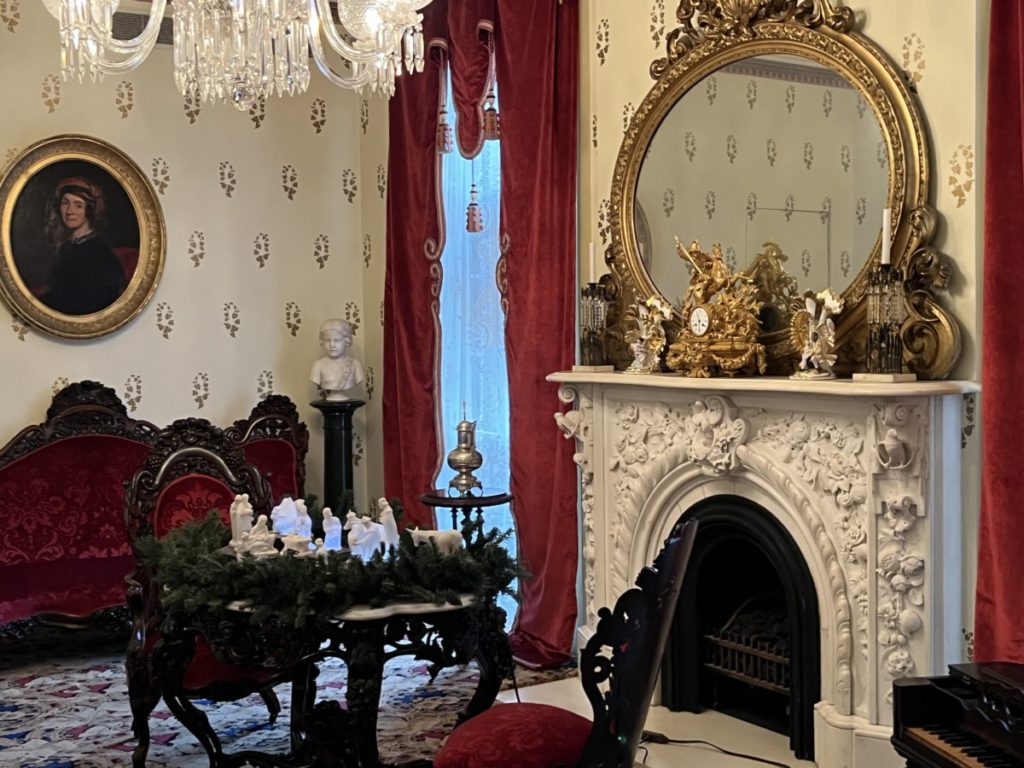
The Chillman Suite, where the servants quarters originally existed, displayed an unusual center table with a landscape scene painted on it. We climbed the back stairs to the upper level of the house.
Second Floor
In the west wing above the Chillman Suite, the Music Room featured a bright wallpaper that would have been prominent in the early 1800s, as well as the square piano with fewer keys than standard pianos today. Music was important to Hogg. Educated at the University of Texas, she later studied piano in New York, Germany, and Austria. Returning to Houston, she founded the Houston Symphony in 1913.
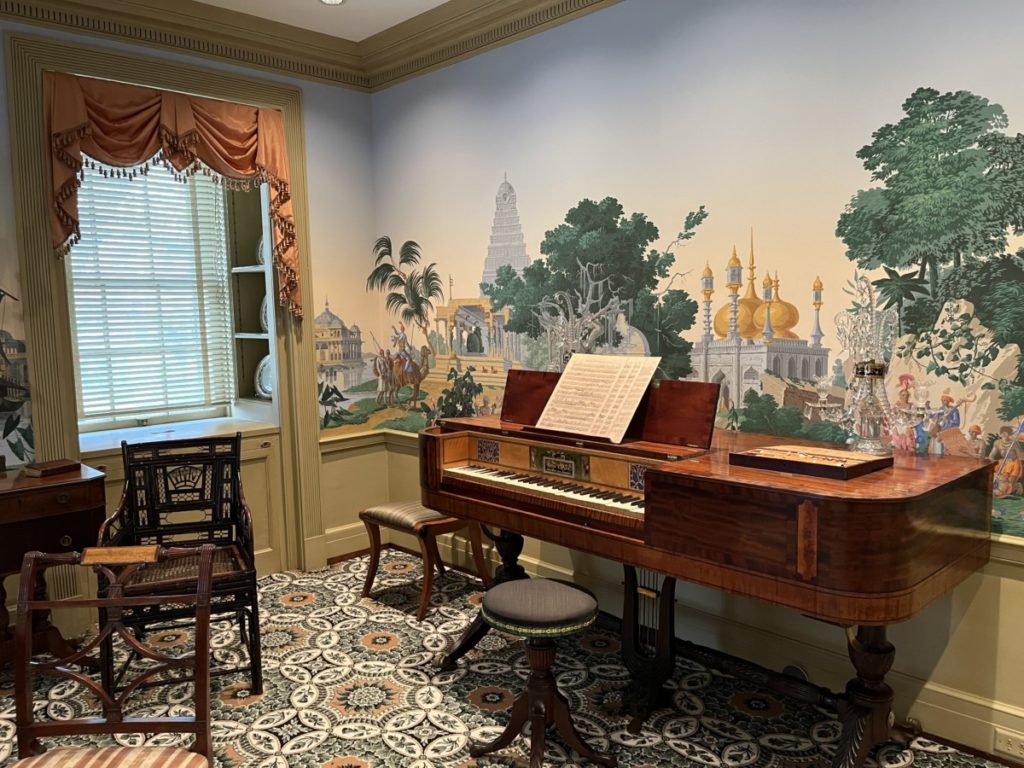
Several upstairs rooms featured bedrooms with period furniture. Imported fabric signified wealth and the use of matching fabric was considered even more of a luxury.
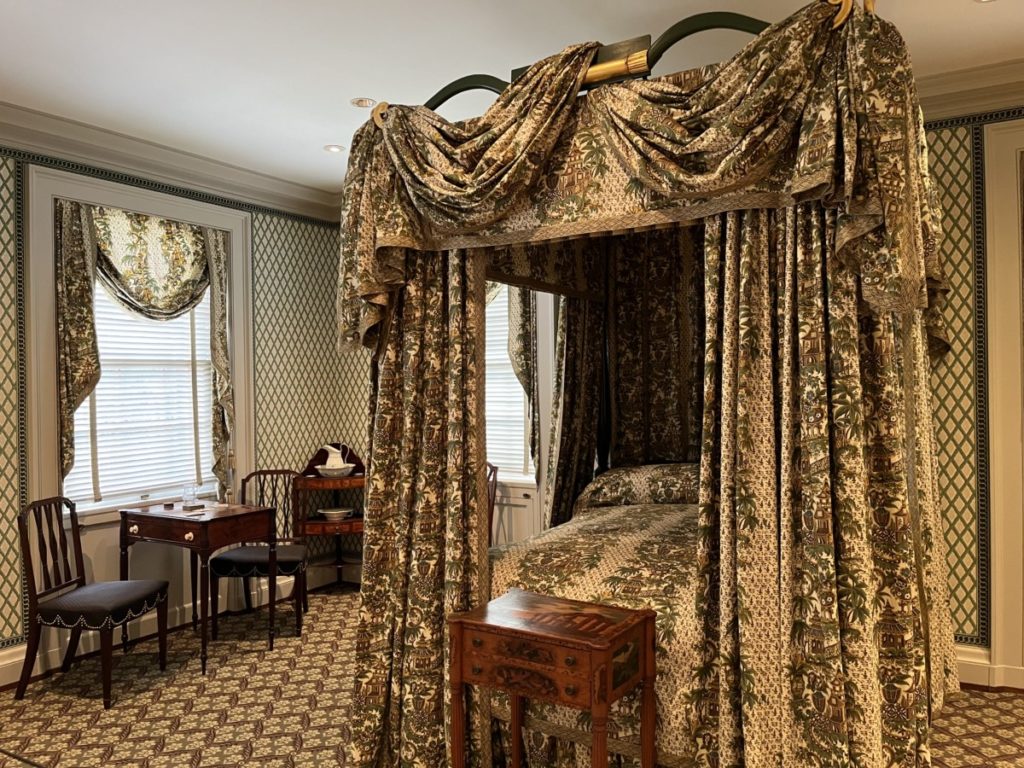

Hogg spent her lifetime collecting historic pieces and devoted several rooms to showcase metals, including pewter and silver, colored glass, and folk art. The Ceramics Study Room displays multiple china patterns, as well as pottery, and pitchers. Although Hogg’s intent was to bring culture to Houston, she did amass a collection of items from Texan artisans and craftsmen. The Texas Room highlighted these objects. Where else can you find a chair made out of longhorns! Hook ’em Horns!

While walking through the Newport Room, Queen Anne Suite, and Federal Parlor, we appreciated Hogg’s gift to the city. In addition to founding the Houston Symphony, she later start the Hogg Foundation for Mental Health, served on the Texas Historical Commission, and donated property in Brazoria County to become the Varner-Hogg Plantation Site. Often called the “First Lady of Texas,” Hogg died at the age of 93.
For more information about visiting Bayou Bend, see the website here.

